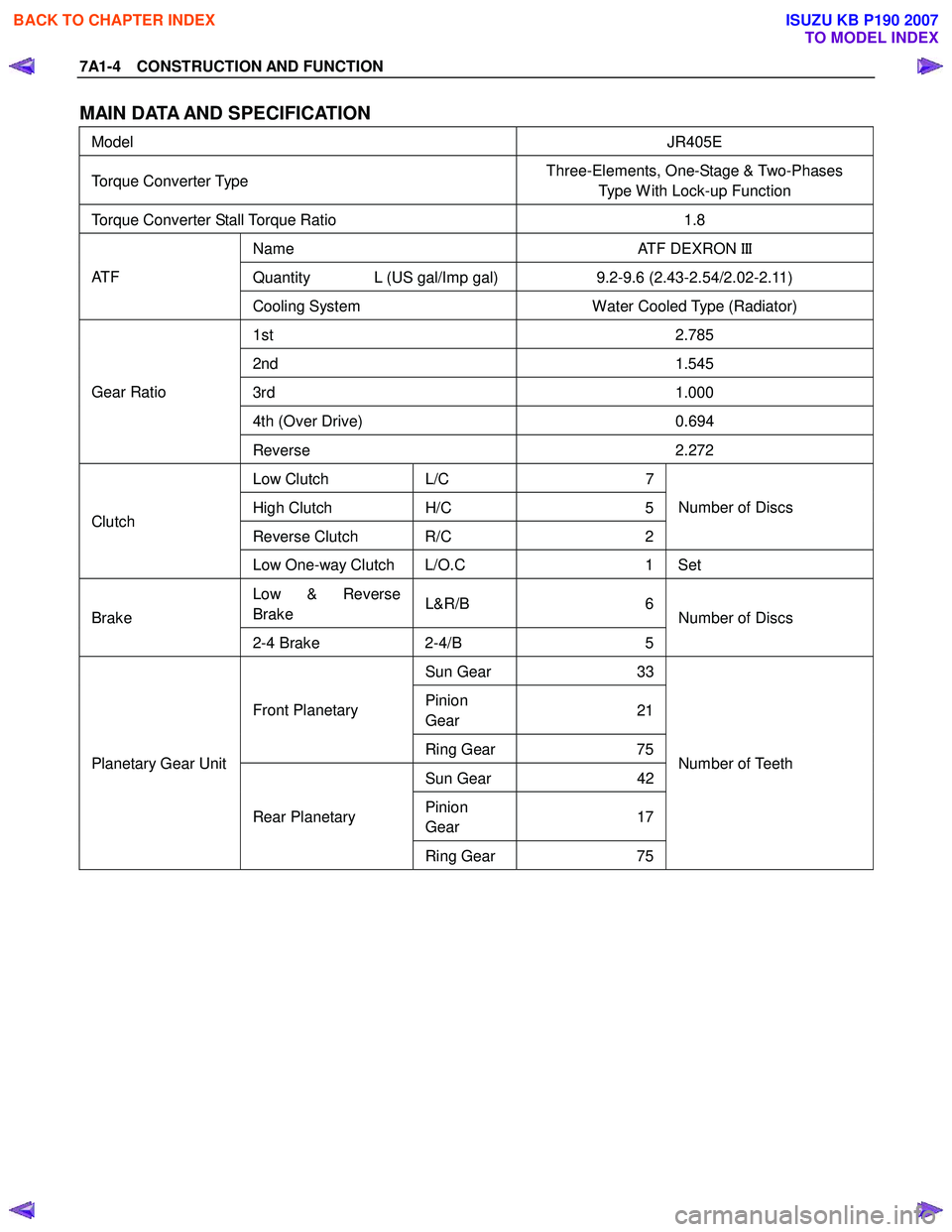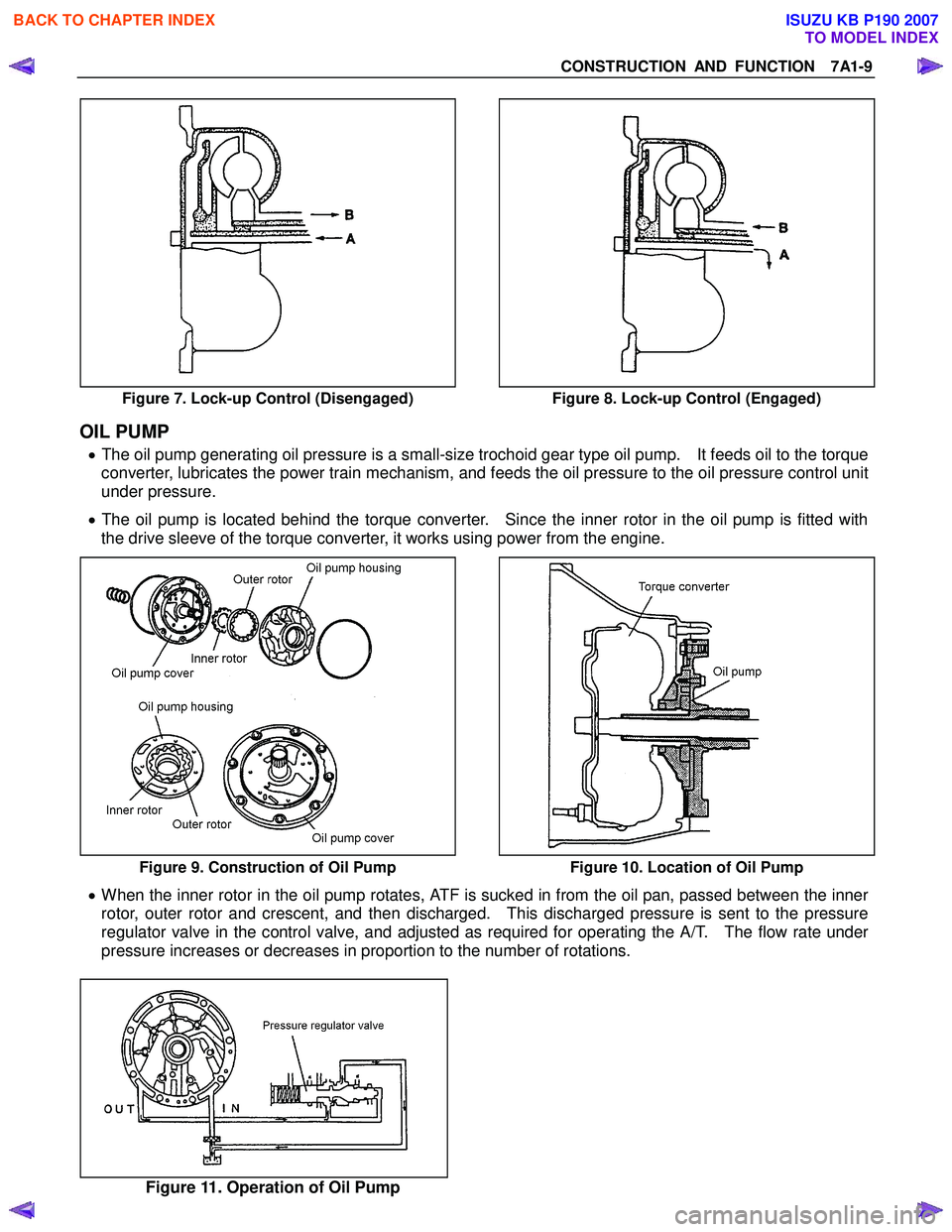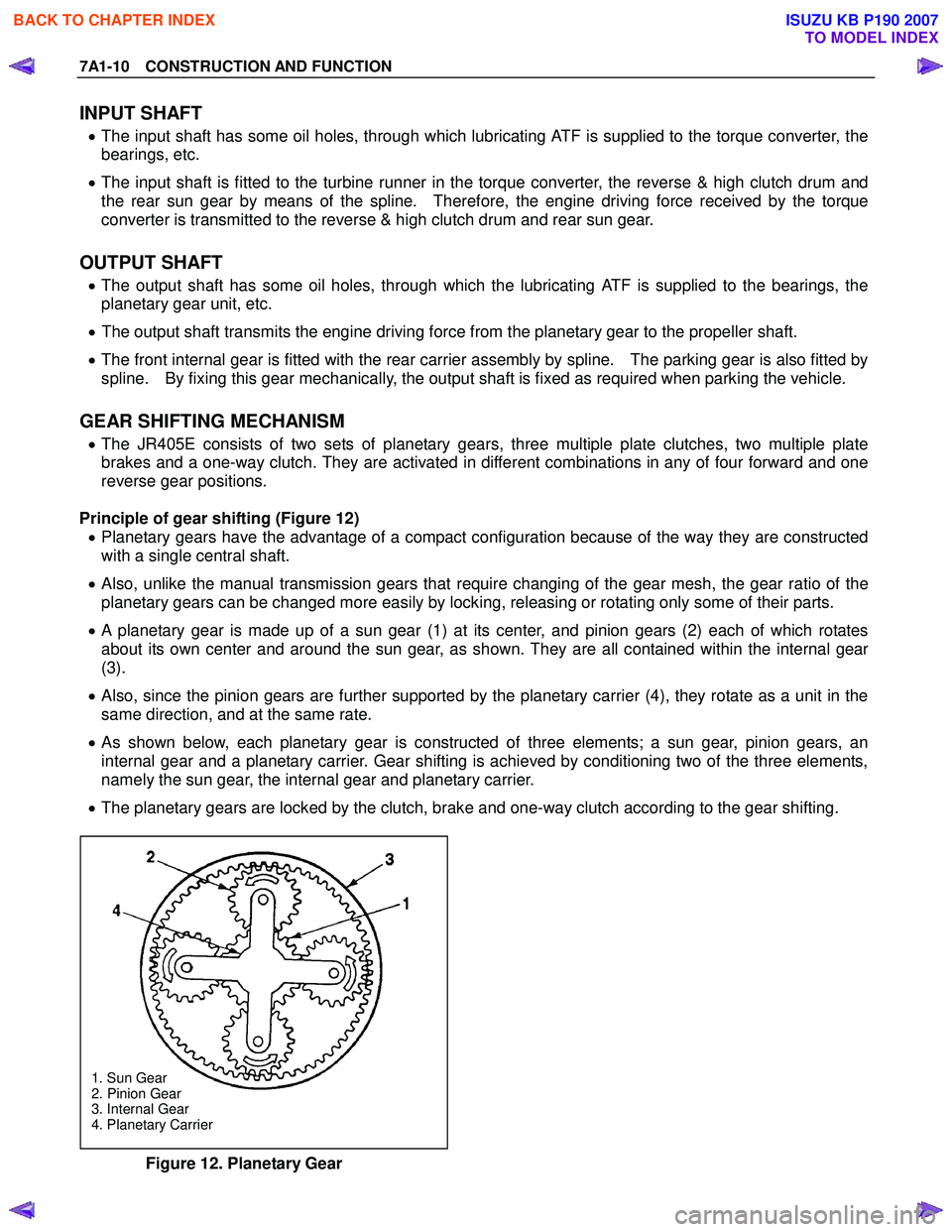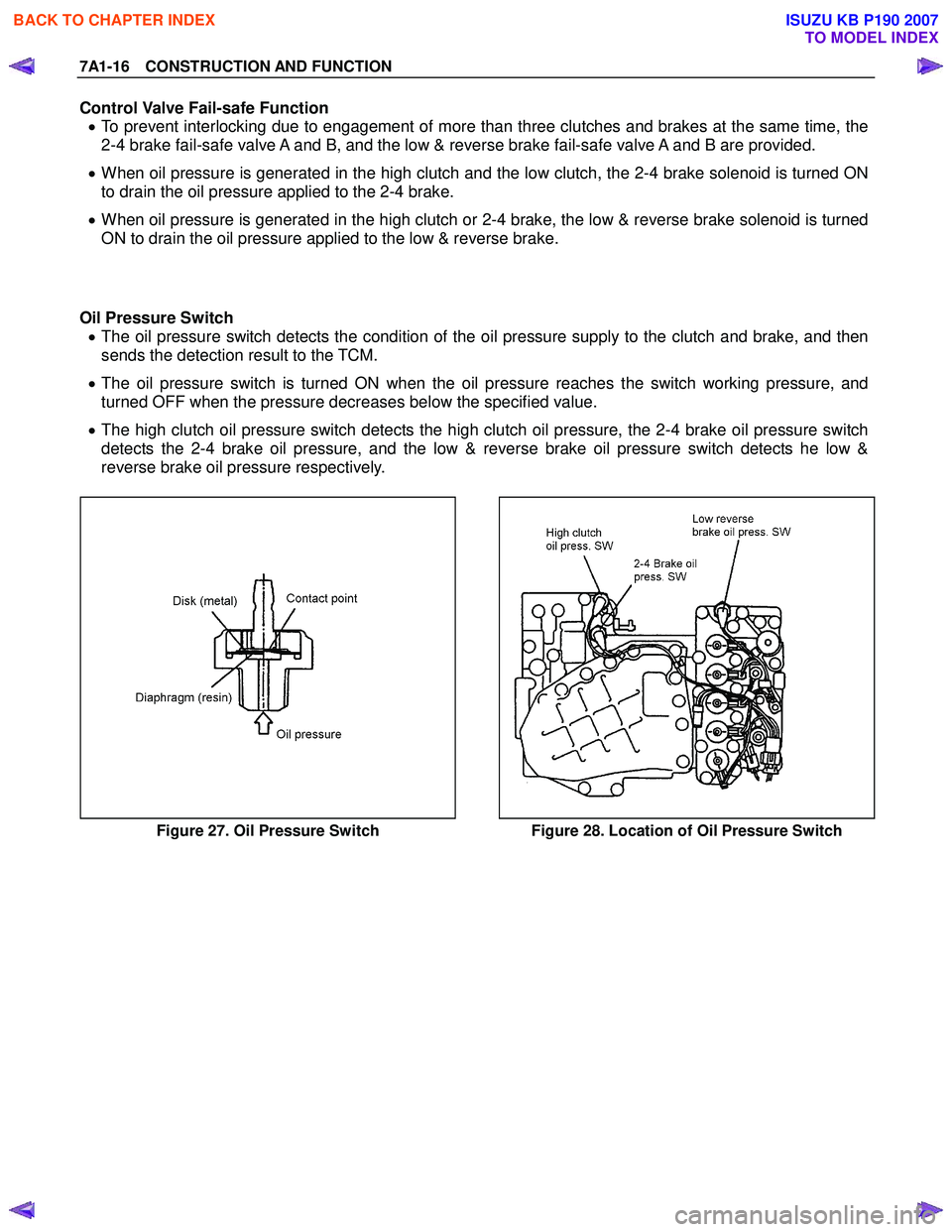lock ISUZU KB P190 2007 Workshop Repair Manual
[x] Cancel search | Manufacturer: ISUZU, Model Year: 2007, Model line: KB P190, Model: ISUZU KB P190 2007Pages: 6020, PDF Size: 70.23 MB
Page 4243 of 6020

7A1-4 CONSTRUCTION AND FUNCTION
MAIN DATA AND SPECIFICATION
Model JR405E
Torque Converter Type Three-Elements, One-Stage & Two-Phases
Type W ith Lock-up Function
Torque Converter Stall Torque Ratio 1.8
Name ATF DEXRON III
Quantity L (US gal/Imp gal) 9.2-9.6 (2.43-2.54/2.02-2.11) AT F
Cooling System Water Cooled Type (Radiator)
1st 2.785
2nd 1.545
3rd 1.000
4th (Over Drive) 0.694
Gear Ratio
Reverse 2.272
Low Clutch L/C 7
High Clutch H/C 5
Reverse Clutch R/C 2Number of Discs Clutch
Low One-way Clutch L/O.C 1 Set
Low & Reverse
Brake L&R/B 6
Brake
2-4 Brake 2-4/B 5 Number of Discs
Sun Gear
33
Pinion
Gear 21Front Planetary
Ring Gear 75
Sun Gear 42
Pinion
Gear 17
Planetary Gear Unit
Rear Planetary Ring Gear 75 Number of Teeth
BACK TO CHAPTER INDEX
TO MODEL INDEX
ISUZU KB P190 2007
Page 4245 of 6020

7A1-6 CONSTRUCTION AND FUNCTION
ELECTRONIC CONTROL COMPONENTS LOCATION
4WD Only 4W D Only
Instrument panel (Meter)
Speed meter (2WD Only)
Shift position indicator lamp
POWER DRIVE, 3rd START
indicator lamp
A/T OIL TEMP indicator lamp
CHECK TRANS indicator lam
p
Brake pedal
Brake Switch
Transmission Control Module (TCM)
Electrical source
Ignition
Battery voltage
Speed sensor
Turbine sensor
Inhibitor switch
ATF thermo sensor
High clutch oil pressure switch
2-4 brake oil pressure switch
Low & Reverse brake oil pressure
switch
Line pressure solenoid
Low clutch solenoid
High clutch solenoid
2-4 brake solenoid
Low & Reverse brake solenoid
Lock-up solenoid
Transmission
Transfer Control Module
Transfer
4L mode switch
Engine
Engine speed sensor
Accelerator pedal Position Sensor
Engine Control Module (ECM)
Data link connector
Select lever
Power Drive
, 3rd Start select switch
Figure 3. Electronic Control Components Location
BACK TO CHAPTER INDEX
TO MODEL INDEX
ISUZU KB P190 2007
Page 4247 of 6020

7A1-8 CONSTRUCTION AND FUNCTION
STRUCTURE AND FUNCTION OF COMPONENT
TORQUE CONVERTER (WITH LOCK-UP FUNCTION)
• The torque converter is a device for transmitting the engine torque to the transmission. It transmits power
by means of oil when the lock-up clutch is disengaged, and by means of a lock-up clutch when it is
engaged.
• The torque converter is of the symmetrical, three-element, single-stage, two-phase type.
• As shown in the drawing, the symmetrical three-elements refer to three elements (components) consisting
of impeller (1), turbine (2) and stator (3) that are arranged symmetrically (figure 5).
• "Single-stage" means that there is only one turbine as an output element; "two-phase" means that the
pump impeller acts as a torque converter when the turbine speed is comparatively low, and as a fluid
coupling when the speed is high.
1. Pump Impeller
2. Turbine Runner
3. Stator
1. Pump Impeller
2. Turbine Runner
3. Stator
4. Converter Cover
5. One-way Clutch
6. Lock-up Piston
7. Torsion Damper
Figure 5. Torque Converter
Figure 6. Construction of Torque Converter
Lock-up mechanism
• "Lock-up" refers to a fixed state of the lock-up clutch inside the torque converter and thus connects the
engine directly to the transmission.
• The hydraulic pressure for the lock-up control is supplied from two circuits.
When the lock-up clutch is disengaged (Figure 7) • When the lock-up is disengaged, the torque converter operating pressure is supplied from the oil pass age
(A) to between the cover and the lock-up piston, and separates the lock-up piston clutch facing and
converter cover.
• As a result, the engine drive power is transmitted from the converter cover to the pump impeller, to the
ATF and to the turbine. The torque converter functions as a fluid connector in this condition.
• The torque converter operating pressure is supplied from oil passage (A), and passes through oil passage
(B).
When the lock-up clutch is engaged (Figure 8) • When the lock-up is engaged, the torque converter operating pressure is supplied from oil passage (B) to
the oil pump impeller, the turbine, and then to the stator side. The oil between the lock-up piston and
converter cover is drained.
• Since the force acting on the right side of the lock-up piston is greater than the force on the left side, it
connects the lock-up piston clutch facing with the converter cover, thereby increasing the transmission
efficiency.
BACK TO CHAPTER INDEX
TO MODEL INDEX
ISUZU KB P190 2007
Page 4248 of 6020

CONSTRUCTION AND FUNCTION 7A1-9
Figure 7. Lock-up Control (Disengaged) Figure 8. Lock-up Control (Engaged)
OIL PUMP
• The oil pump generating oil pressure is a small-size trochoid gear type oil pump. It feeds oil to the torque
converter, lubricates the power train mechanism, and feeds the oil pressure to the oil pressure control unit
under pressure.
• The oil pump is located behind the torque converter. Since the inner rotor in the oil pump is fitted with
the drive sleeve of the torque converter, it works using power from the engine.
Figure 9. Construction of Oil Pump Figure 10. Location of Oil Pump
• When the inner rotor in the oil pump rotates, ATF is sucked in from the oil pan, passed between the inner
rotor, outer rotor and crescent, and then discharged. This discharged pressure is sent to the pressure
regulator valve in the control valve, and adjusted as required for operating the A/T. The flow rate under
pressure increases or decreases in proportion to the number of rotations.
Figure 11. Operation of Oil Pump
BACK TO CHAPTER INDEX
TO MODEL INDEX
ISUZU KB P190 2007
Page 4249 of 6020

7A1-10 CONSTRUCTION AND FUNCTION
INPUT SHAFT
• The input shaft has some oil holes, through which lubricating ATF is supplied to the torque converter, the
bearings, etc.
• The input shaft is fitted to the turbine runner in the torque converter, the reverse & high clutch drum and
the rear sun gear by means of the spline. Therefore, the engine driving force received by the torque
converter is transmitted to the reverse & high clutch drum and rear sun gear.
OUTPUT SHAFT
• The output shaft has some oil holes, through which the lubricating ATF is supplied to the bearings, the
planetary gear unit, etc.
• The output shaft transmits the engine driving force from the planetary gear to the propeller shaft.
• The front internal gear is fitted with the rear carrier assembly by spline. The parking gear is also fitted by
spline. By fixing this gear mechanically, the output shaft is fixed as required when parking the vehicle.
GEAR SHIFTING MECHANISM
• The JR405E consists of two sets of planetary gears, three multiple plate clutches, two multiple plate
brakes and a one-way clutch. They are activated in different combinations in any of four forward and one
reverse gear positions.
Principle of gear shifting (Figure 12) • Planetary gears have the advantage of a compact configuration because of the way they are constructed
with a single central shaft.
• Also, unlike the manual transmission gears that require changing of the gear mesh, the gear ratio of the
planetary gears can be changed more easily by locking, releasing or rotating only some of their parts.
• A planetary gear is made up of a sun gear (1) at its center, and pinion gears (2) each of which rotates
about its own center and around the sun gear, as shown. They are all contained within the internal gear
(3).
• Also, since the pinion gears are further supported by the planetary carrier (4), they rotate as a unit in the
same direction, and at the same rate.
• As shown below, each planetary gear is constructed of three elements; a sun gear, pinion gears, an
internal gear and a planetary carrier. Gear shifting is achieved by conditioning two of the three elements,
namely the sun gear, the internal gear and planetary carrier.
• The planetary gears are locked by the clutch, brake and one-way clutch according to the gear shifting.
1. Sun Gear
2. Pinion Gear
3. Internal Gear
4. Planetary Carrier
Figure 12. Planetary Gear
BACK TO CHAPTER INDEX
TO MODEL INDEX
ISUZU KB P190 2007
Page 4252 of 6020

CONSTRUCTION AND FUNCTION 7A1-13
2-4 Brake and Low & Reverse Brake (Multi-Plate Brake) • The multi-plate brake is composed of drive plates and driven plates. By applying the oil pressure onto
the end surface of the plates, the clutch is engaged. The oil pressure is adjusted with the control valve
according to the signal from the TCM.
• All brakes use dish plates to prevent uncontrolled operation of the clutches when engaged, causing a
shock.
• The solenoid in the control valve is driven based on the shift signal from TCM, it moves the shift valve,
thereby engaging the drive plate and driven plate through the piston of each clutch.
• As a result, rotation of each element of the planetary gear unit is fixed.
• When the oil pressure is removed, the piston returns to the original position via the force of the return
spring.
Figure 19. Construction of 2-4 Brake
Figure 20. Construction of Low & Reverse Brake
Low One-way Clutch
• The low one-way clutch employs the sprag, which locks the counterclockwise rotation of the front
planetary carrier and the rear internal gear.
• The one-way clutch outer race is fitted with the low clutch drum, and the inner race is fitted with the
transmission case.
• The outer race rotates freely clockwise, but, when it attempts to rotate counterclockwise, the sprag locks
the outer race.
• When the vehicle is traveling in 1st gear in the D, 3 or 2 position, the low one-way clutch locks the rear
internal gear via the low clutch. It is left free in the 2nd, 3rd or 4th gear.
Figure 21. Construction of Low One-way Clutch
BACK TO CHAPTER INDEX
TO MODEL INDEX
ISUZU KB P190 2007
Page 4254 of 6020

CONSTRUCTION AND FUNCTION 7A1-15
Line Pressure Solenoid • The line pressure solenoid is turned ON or OFF according to the signal from the TCM. It switches the
line pressure between high and low pressure.
• While no power is supplied, the solenoid supplies high pressure.
Shift Solenoid • The shift solenoid is of the duty cycle type, which is turned ON or OFF at 50Hz. The ratio of the ON and
OFF time can be freely controlled in the position of 0 - 100%.
• While no power is supplied, the solenoid supplies output pressure.
• The low clutch solenoid adjusts the low clutch pressure, the high clutch solenoid adjusts the high clutch
pressure, the 2-4 brake solenoid adjusts the 2-4 brake pressure, and the low & reverse brake solenoid
adjusts the low & reverse brake pressure respectively.
Lock-up Solenoid • The lock-up solenoid is of the duty cycle type which is turned ON or OFF at 50Hz. The ratio of the ON
and OFF time can be freely controlled in the position of 0 - 100%.
• While no power is supplied, the solenoid drains the output pressure.
Figure 23. Shift Solenoid Figure 24. Lock-up Solenoid
Figure 25. Location of Solenoid
BACK TO CHAPTER INDEX
TO MODEL INDEX
ISUZU KB P190 2007
Page 4255 of 6020

7A1-16 CONSTRUCTION AND FUNCTION
Control Valve Fail-safe Function • To prevent interlocking due to engagement of more than three clutches and brakes at the same time, the
2-4 brake fail-safe valve A and B, and the low & reverse brake fail-safe valve A and B are provided.
• When oil pressure is generated in the high clutch and the low clutch, the 2-4 brake solenoid is turned ON
to drain the oil pressure applied to the 2-4 brake.
• When oil pressure is generated in the high clutch or 2-4 brake, the low & reverse brake solenoid is turned
ON to drain the oil pressure applied to the low & reverse brake.
Oil Pressure Switch • The oil pressure switch detects the condition of the oil pressure supply to the clutch and brake, and then
sends the detection result to the TCM.
• The oil pressure switch is turned ON when the oil pressure reaches the switch working pressure, and
turned OFF when the pressure decreases below the specified value.
• The high clutch oil pressure switch detects the high clutch oil pressure, the 2-4 brake oil pressure switch
detects the 2-4 brake oil pressure, and the low & reverse brake oil pressure switch detects he low &
reverse brake oil pressure respectively.
Figure 27. Oil Pressure Switch Figure 28. Location of Oil Pressure Switch
BACK TO CHAPTER INDEX
TO MODEL INDEX
ISUZU KB P190 2007
Page 4257 of 6020

7A1-18 CONSTRUCTION AND FUNCTION
Terminal Assembly Pin No. Connected to Connected TCMPin No.
6 Line Pressure Solenoid B23
12 Low & Reverse Brake Oil Pressure Switch B12
5 Low & Reverse Brake Duty Solenoid B6
11 Ground Return B22
4 Lock-up Duty Solenoid B17
10 High Clutch Duty Solenoid B8
3 Low Clutch Duty Solenoid B9
9 2-4 Brake Duty Solenoid B7
2 Oil Thermo Sensor B4
8 Oil Thermo Sensor Ground B14
1 High Clutch Oil Pressure Switch B20
7 2-4 Brake Oil Pressure Switch B1
123456
891011127
Terminal AssemblyInhibitor Switch
Figure 31. Pin Assignment Figure 32. Location of Terminal Assembly
BACK TO CHAPTER INDEX
TO MODEL INDEX
ISUZU KB P190 2007
Page 4259 of 6020

7A1-20 CONSTRUCTION AND FUNCTION
Figure 34. Oil Passage of Oil Pump
PARKING FUNCTION
• By setting the select lever to the P position, the parking pawl is engaged with the parking gear and fixes
the output shaft.
• By moving the select lever, the manual shaft on the right side of the AT is moved. The manual plate and
parking rod in the AT are interlocked with the manual shaft. When the manual shaft moves, the parking
rod end pushes up the parking pawl.
• The parking pawl is engaged with the parking gear when pushed up, and fixes the output shaft.
• When the clutch is disengaged, it returns to the original position via the force of the return spring, fixed to
the parking pawl.
Figure 35. Parking Function
BACK TO CHAPTER INDEX
TO MODEL INDEX
ISUZU KB P190 2007